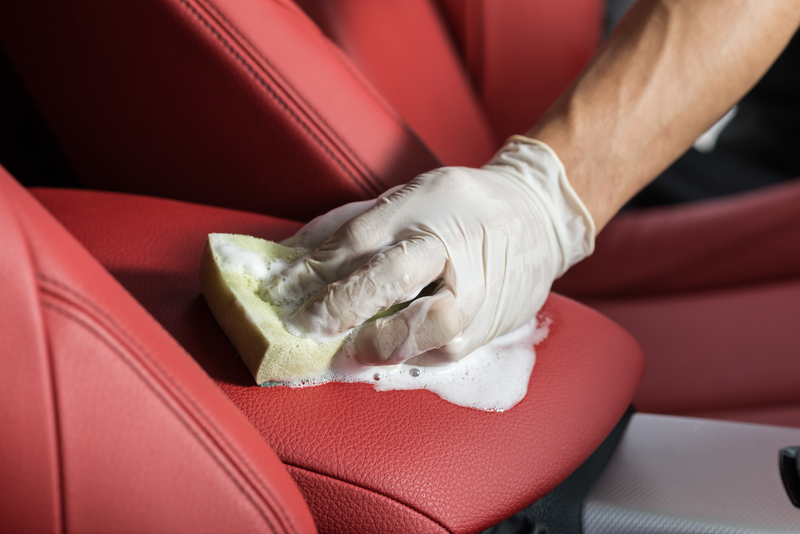Effective Tips for a Mold-Free Bathroom Environment
Posted on 27/08/2025
Effective Tips for a Mold-Free Bathroom Environment
Mold is a persistent and unwelcome guest in many homes, especially in bathrooms where moisture and warmth create the perfect breeding ground. Throughout this comprehensive guide, you'll discover actionable and effective tips for a mold-free bathroom environment. Whether you're looking to prevent issues or address an existing problem, these strategies will help you maintain freshness and health in your home.

Why Bathrooms are Prone to Mold Growth
Before diving into prevention methods, it's essential to understand why bathrooms are susceptible to mold infestation. The main factors include:
- High humidity: Daily activities like showering, bathing, and washing generate significant moisture.
- Poor ventilation: Inadequate airflow allows moisture to linger, creating a mold-friendly environment.
- Warm temperatures: Heat accelerates mold growth, and bathrooms are typically warm spaces.
- Organic materials: Items like wood, paper, or cloth-based products absorb moisture and support mold development.
Grasping these contributing factors is the first step toward implementing effective mold control solutions for your bathroom.
Top Preventive Measures for a Mold-Free Bathroom
1. Optimize Ventilation Systems
Proper ventilation is the cornerstone of a mold-free bathroom. Without sufficient airflow, humidity accumulates, sparking fungal growth. To enhance air circulation:
- Use an exhaust fan: Ensure a quality exhaust fan is installed and operational. Run it during and at least 15-20 minutes after using the shower or bath.
- Open windows: If possible, crack open a window during or after bathing to let moist air escape naturally.
- Leave doors ajar: Keep the bathroom door slightly open for additional airflow and to prevent moisture buildup.
- Clean vents regularly: Dust and debris clog fans and vents, reducing effectiveness. Schedule periodic cleanings.
2. Minimize Humidity and Moisture
Moisture management is crucial to preventing mold in bathrooms. To keep humidity in check:
- Use a dehumidifier: For persistently damp bathrooms or during humid seasons, a small dehumidifier can help maintain optimal humidity levels (30-50%).
- Monitor humidity: Install a humidity sensor or hygrometer to track moisture and take timely action.
- Wipe wet surfaces: After showers, quickly wipe down tiles, mirrors, and windows to reduce lingering moisture.
- Fix leaks promptly: Leaky pipes, faucets, and toilets create hidden damp spots--repair them as soon as detected.
3. Choose Mold-Resistant Materials
Make smart decisions when remodeling or refreshing your bathroom to support a mold-resistant bathroom environment:
- Mold-resistant paint: Use specially formulated paint on walls and ceilings. These paints contain antimicrobial agents that deter fungal growth.
- Water-repellent grout: Opt for epoxy-based grout or add a grout sealer to prevent water penetration between tiles.
- Install moisture-resistant wallboard: Ditch traditional drywall in favor of cement board for areas exposed to water.
- Non-porous surfaces: Glass, glazed ceramic, and acrylic are less likely to harbor mold than porous materials like unsealed wood or stone.
4. Mold-Preventive Cleaning Habits
A consistent cleaning routine is one of the most effective mold prevention tips for bathrooms. Key habits include:
- Clean showers and tubs weekly: Scrub all surfaces to remove soap scum, which feeds mold. Use a dedicated cleanser or a homemade vinegar solution.
- Wash bath mats and towels: These items absorb moisture and harbor mold. Launder them at least weekly and ensure they dry thoroughly between uses.
- Empty trash bins regularly: Bathroom waste often contains tissues and personal care items that trap moisture.
- Use a daily shower spray: Ready-to-use antimicrobial sprays prevent buildup and inhibit mold regrowth.
Addressing Common Mold-Prone Areas
Shower Curtains and Liners
Shower curtains are notorious for developing mold, particularly at the bottom where water collects. To prevent this:
- Use machine-washable liners: Wash them biweekly with hot water and bleach or vinegar.
- Keep curtains extended: After showering, fully extend the curtain to allow faster drying and minimize folds that trap water.
- Swap plastic for fabric: Some fabric liners dry faster and are less prone to mold compared to standard plastic versions.
Grout and Tile Joints
Tile and grout are prime suspects for mold, especially in showers and around tubs. Combat these trouble spots by:
- Sealing grout lines: Apply a grout sealer annually to keep water from penetrating porous grout.
- Spot cleaning mold: Use a paste of baking soda and water, or an enzyme cleaner, to scrub discolored grout.
- Addressing cracked grout: Repair cracks promptly to keep moisture from seeping behind tiles.
Bathroom Ceilings and Walls
Steamed-up walls and ceilings are a common sight after hot showers, but they're also frequent mold targets. Prevention tips:
- Repaint as needed: Refresh high-risk areas with mold-inhibiting paint every few years.
- Check corners and behind fixtures: Mold often lurks in hidden or seldom-cleaned spots.
- Use fans strategically: Aim portable fans upwards after bathing to help dry ceilings quickly.
Immediate Steps for Eliminating Existing Mold
If you spot mold in your bathroom, don't panic. With swift and safe action, you can eradicate small outbreaks effectively:
- Ventilate the area: Open windows, doors, and use fans during cleaning to minimize exposure to spores and fumes.
- Wear protection: Gloves, goggles, and a mask prevent direct contact and inhalation of mold particles.
- Choose the right cleaner: Use a solution of one part bleach to ten parts water, commercial mold removers, or natural alternatives (vinegar or hydrogen peroxide).
- Scrub surfaces: Use a stiff brush for tiles and grout. For fabric items, deep wash or replace if necessary.
- Dry thoroughly: Make sure all treated areas are completely dry after cleaning to deter regrowth.
Note: If mold covers a large area (>10 sq. ft), or recurs frequently, it may indicate a deeper issue requiring professional remediation.
Upgrading Bathroom Fixtures for Lasting Mold Prevention
For a truly mold-resistant bathroom, consider these fixture upgrades:
- Touchless faucets: Combining convenience and hygiene, touchless models reduce water splashes that feed mold.
- Wall-mounted toilets and sinks: These fixtures minimize creases and nooks where water and mold accumulate, making cleaning a breeze.
- Shower enclosures: Well-sealed glass enclosures instead of curtains significantly limit water spread and mold risk.
- Heated towel racks: These help dry towels quickly, preventing dampness.
Creating and Maintaining a Mold-Free Routine
Consistency is key in achieving a permanently mold-free bathroom. Consider these routine steps:
- Daily: Leave the shower door/curtain open, run an exhaust fan, and quickly wipe wet surfaces.
- Weekly: Clean tiles, grout, and heavily-trafficked surfaces. Wash linens and mats.
- Monthly: Check for leaks, clean vent covers, and inspect for odors or visible mold.
- Annually: Reseal grout, deep clean hard-to-reach spots, and reassess ventilation performance.
Additional Eco-Friendly Tips for Mold-Free Bathrooms
If you prefer natural alternatives and eco-friendly practices, try these ideas to support a mold-safe bathroom environment:
- Avoid harsh chemicals: Opt for vinegar, baking soda, tea tree oil, or hydrogen peroxide as greener mold solutions.
- Decorate with plants: Some houseplants like Boston ferns and peace lilies help regulate humidity while adding beauty.
- Install bamboo mats: Bamboo is naturally resistant to mold and mildew, making it an ideal bath mat choice.
- Use low-flow fixtures: These reduce excess splashing and puddling, lessening overall dampness.

What to Do When Mold Persists
Repeated mold outbreaks in the bathroom may signal hidden leaks, structural issues, or insufficient airflow. In such cases:
- Consult a professional: If mold returns despite all efforts, a specialist can assess for plumbing faults, ventilation design, or hidden water intrusion.
- Address root causes: Structural repairs, advanced waterproofing, or enhanced exhaust systems might be necessary for lasting results.
- Regular monitoring: Make mold checks a regular part of your household maintenance.
Conclusion: Enjoy a Healthier, Mold-Free Bathroom
Achieving a mold-free bathroom environment is fully possible with mindful design decisions, proper cleaning routines, and vigilant moisture control. Effective mold prevention not only enhances the comfort and aesthetic of your bathroom, but also protects your family's health and adds value to your home.
To recap, focus on ventilation, moisture control, smart material choices, diligent cleaning, and regular inspections to keep your bathroom pristine and safe. Start implementing these tips today and enjoy a fresh, healthy, and mold-free sanctuary!




